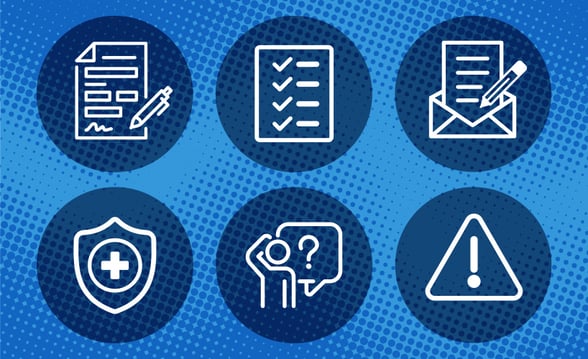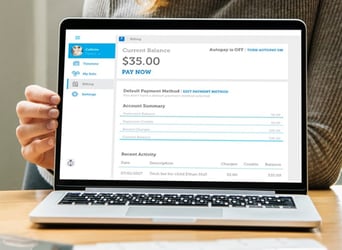
With more parents in the workforce than ever, daycare is in great demand. According to Grand View Research, the market, which was estimated at $61.70 billion in 2023, is expected to grow by 5.86% by 2030, reaching $91.68 billion. These numbers reveal the industry can be quite lucrative and rewarding.
However, your daycare startup will only be successful if you create a comprehensive daycare business plan. You must consider how you will operate, your childcare licensing requirements and legal obligations, staffing needs, facility choice and marketing. This article explains how to open a daycare and develop it into a reputable company.
Table of Contents
- Step 1 – Researching and Planning Your Daycare Business
- Step 2 – Creating a Daycare Business Plan
- Step 3 – Licensing and Legal Requirements
- Step 4 – Securing Funding for Your Daycare
- Step 5 – Setting Up Your Daycare Facility
- Step 6 – Hiring and Training Staff
- Step 7 – Developing a Curriculum and Daily Schedule
- Step 8 – Marketing Your Daycare Center
- Step 9 – Enrolling Children and Managing Operations
- FAQs
- 100+ Free Printable Templates to Make Running Your Daycare Easier
Download our free kit of 100+ Templates, Marketing Guide, Automation Tips, & Checklists for valuable information to help you get your daycare facility off the ground.
Step 1 - Researching and Planning Your Daycare Business

Before you do anything else, you should begin researching and planning your daycare business. Your insights will help you determine what you can expect regarding profitability and how to open a daycare and run your operations. It will prepare you for your professional journey.
Understanding the Daycare Industry Landscape
Individuals wondering how to run a successful daycare must first understand the landscape, including these components:
- Demand: Childcare is generally in high demand, but you must consider the demand in your location.
- Trends: What are parents looking for in daycare? Many want a focus on education and school preparation. There may also be preferences for certain curriculum types.
- Technology: What technology are daycare centers using to make their processes more efficient?
- Staffing: What are parents looking for regarding skills and certifications in staff members?
- Expenses: What expenses will you incur early on, and when will you see returns on those investments?
- Regulations and compliance: How will you ensure your company complies with legal standards and regulations?
Identifying Your Target Market and Local Childcare Needs
Determining your target market is easy — you need to connect with families with young children. But where will you find them and what are they looking for in a childcare facility?
Here are some helpful tips:
- Find your target audience: Go to family-oriented events and locations in your community, such as parks, schools and county fairs. Talk to parents and give out fliers.
- Connect digitally: You may also connect with parents on social media and other online platforms. Focus on local search engine optimization (SEO) to ensure you reach parents in your community.
- Know what they want: Prepare your marketing materials emphasizing that you offer the services parents want most. Today's parents appreciate daycare centers that focus on learning through play, technology integration, personalized learning and developing social and emotional skills.
Choosing the Right Type of Daycare
You must also consider the type of daycare program you will offer. Will it be home-based or center-based? Here are some pros and cons to consider.
Center-Based Pros
- More structured environment: Commercial daycare centers may provide a more structured environment for learning and activities.
- Convenient locations: Commercial facilities may offer the best location for a daycare center. They typically operate in commercial zones that are more visible and accessible.
- Staffing: A commercial center’s visibility may help attract more qualified staff members.
- Meal programs: Some commercial daycare centers may be eligible for federal food programs providing kids with nutritious meals and snacks.
- Higher quality standards: A commercial center may be upheld to higher business standards, ensuring better service.
Center-Based Cons
- Expenses: Business owners are typically required to rent or own the facility, which increases daycare startup costs.
- Less individualized attention: Commercial centers tend to have larger groups, resulting in less personalized attention for each child.
- Higher potential germ spread: Larger groups also mean a higher potential for germ spread.
Home-Based Pros
- Less expensive: Running operations out of the home reduces the expenses of renting or owning a facility.
- Personalized attention: Home-based centers have smaller groups so staff members can pay more attention to each child.
- Flexible schedules: Home providers may offer more flexible schedules to accommodate parent's needs.
- More relaxed environment: Children may feel more comfortable in a home setting.
Home-Based Cons
- Less structured environment: The less structured environment means there may be less support for children's activities.
- Limited socialization: The small groups at home-based centers limit socialization opportunities.
- Less support: Home-based daycare centers have fewer staff members and may not have backup support when someone calls in sick.
Step 2 - Creating a Daycare Business Plan
The next step involves creating a childcare business plan to guide your operations and help attract investors.
Why a Business Plan is Essential
A business plan for daycare will support your venture in many ways, for example:
- Refines your business idea: Putting your business idea into writing helps you refine it and identify gaps and weaknesses. It also forces you to consider your target market and how to run a successful daycare and stay viable in a competitive landscape.
- Attracts investors and funding: Anyone considering investing in your business or providing a loan will want to see a business plan. It will give them a clear picture of your financial projections and funding needs.
- Reduces risks: Your business plan will make you aware of your risks so you can address and mitigate them.
- Communicates your vision: You can pass your business plan along to stakeholders so they better understand your vision.
- Provides a roadmap: Your business plan outlines your goals and strategies so you know how to achieve them. It also helps you make key business decisions.
Key Components of a Business Daycare Plan
So, what should your business daycare plan include? Here are some essentials.
Mission and Vision Statement
- Mission statement: Defines your daycare's current purpose
- Example: We provide a safe space to guide children to success and help families thrive.
- Vision statement: Describes your daycare's future goals
- Example: To make a brighter future for our community by supporting child development and family finances.
Both your mission and vision statements should be short, with the mission statement typically being no more than a sentence and the vision statement being a few sentences at most.
Services Offered
Services offered can fall into several categories:
- Schedule: Will you offer full-time, part-time or after-hours care?
- Program type: Will you provide preschool or general daycare for younger children?
- Curriculum type: Will your curriculum be art-based? Will you focus on social and emotional learning? Will you take a more general approach?
Budget and Financial Projections
- Your budget should set a plan for your financial resources for a specific period, typically a year, outlining financial goals and allocating resources on how to achieve them.
- Financial projections forecast your financial performance, allowing you to attract investors and make financial decisions. They predict the company's economic future, including income, expenses and cash flow.
Staffing Needs and Operational Costs
Your childcare business plans must include your staffing needs and operational costs:
- Staffing: What staff do you need to run your company, considering caregivers and administrative roles? What are the required qualifications for each role? Consider training, hiring strategies, certifications and pay rates.
- Operational costs: Daycare startup costs may include rent, utilities, staff salaries, insurance, marketing and advertising, licensing fees, equipment and maintenance.
Step 3 - Licensing and Legal Requirements
Daycare centers must meet specific legal and childcare licensing requirements to operate. Here are some to consider.
State and Local Licensing Regulations
All daycare facilities must be licensed. However, childcare license requirements vary from state to state. For example, all states require a daycare license, but some may require an additional business license. There are also differences in how to obtain permits among states.
Here are some topics to research to ensure you get the licensing you require:
- State-specific requirements: Contact your local government or use the ChildCare.gov website to learn about your area's childcare licensing requirements.
- Compliance: Ensure you comply with all state laws and regulations applicable to your license. Most states require you to fill out an application and pay a fee.
- Ongoing maintenance: You may be subject to checkups to ensure you comply with the regulations of your license. Renewals may also be necessary. Learn what's involved to ensure you don't lose your license.
Safety and Health Compliance
States also have laws ensuring your facility meets health and safety regulations for daycare. Here are some examples:
- Staff health: States may require that staff take specific exams and screenings and get vaccinated before working in a daycare setting.
- Child health: Children may need physical exams and vaccinations before attending daycare.
- Sanitation: The center may set regulations for sanitizing toys and equipment and handwashing.
- Safe food handling: Staff members may be required to attend food safety training classes to ensure they handle food safely.
- Facilities: The facility must be clean, safe and secure, posing no safety risks to children or staff.
- Emergency preparedness: Children and staff should learn what to do in an emergency.
- Staff-to-child ratios: States may enforce staff-to-child ratios, usually 1:10 for younger children. For infants, ratios may be closer to 1:4.
- Safe sleep arrangements: Work out safe sleep arrangements for infants.
Liability Insurance for Daycare
All states require liability insurance for daycare programs; however, the type of liability needed can vary. Regardless, you should consider the various types of daycare insurance and choose policies suited to your needs. Here are some to consider.
- General Liability covers medical expenses related to injuries on the premises, property damage caused by accidents and vandalism, and advertising liability, which covers lawsuits related to false or misleading advertising.
- Professional Liability, also called Errors and Omissions (E&O) Liability, covers claims due to failure to provide adequate care, such as a child's injury due to inadequate supervision.
- Workers' Comp covers workers' injuries due to accidents on the job.
- Commercial Vehicle Insurance covers damages related to accidents in commercial vehicles, such as buses that take children to and from school and field trips.
- Abuse and Molestation covers claims related to abuse and molestation.
Step 4 - Securing Funding for Your Daycare
Starting an early childhood education business is a substantial financial undertaking. Most business owners don't have the money on hand. However, finding funding for daycare is possible with the following strategies.
Startup Costs Breakdown
First, you must consider your expenses to determine how much funding you'll need. Startup expenses generally include:
- Rent: The rent you pay on your facility
- Equipment: May include furniture, cribs, strollers, playpens, toys, educational materials, art supplies, first aid kits, fire extinguishers, safety gates and locks, diapers and diaper pails, cleaning solutions, hand sanitizers, computers and technology and storage solutions
- Staff salaries: How much you will pay your staff, considering reasonable salaries for each position
- Licensing fees: How much you will pay for your initial license, renewals and any training required
Funding Options for Your Daycare
The costs of starting a childcare business can add up, but these solutions will help you reduce expenses and make finding funding for daycare easier:
- Government grants: Daycare is a valuable service and governments often offer grants to support these efforts. The space is competitive, but with some perseverance, you may be able to secure grants to help your company. Contact resources like the Child Care Resource and Referral (CCR&R) agency, the Administration for Children and Families (ACF) and Grants.gov to learn about opportunities in your area.
- Small business loans: Some banks offer business loans; however, you may be better off going directly to the Small Business Administration (SBA), which provides billions of dollars in daycare loans and offers low interest rates. You will have high loan success rates if you show a good credit score and adequate income levels. Try paying off debts before you apply to ensure your chances of getting reasonable terms and rates.
- Crowdfunding: Crowdfunding is another way to raise money for your daycare venture. Find the right platform and create a compelling campaign. Promote your campaign to ensure you attract donors. Offer small gifts in return for donations to incentivize giving.
Managing Tuition Payments Effectively
A good portion of your income will come from tuition, but you could lose money if you are not managing daycare payments effectively. Vanco's payment solutions can help.
Our payment system automates payments, including splits, fees and subsidies, offering a centralized process. The paperless system ensures you never lose a document. It also offers next-level security, keeping sensitive information safe.
Step 5 - Setting Up Your Daycare Facility
Once your funding is in place, you must start getting your facility off the ground. Here's what's involved.
Choosing the Right Location
The first step is to find the best location for a daycare center. Here are some things to consider.
- Home care vs. commercial daycare center: Review the pros and cons to determine the right choice.
- Choose a visible location: Choose a location that gets plenty of foot traffic and visibility to attract people to your early childhood education business. Preferably, find an area close to family-friendly centers like parks and schools.
- Consider parking: A parking area could be a bonus for families in the market for daycare facilities.
- Check zoning regulations: Ensure there are no zoning regulations that would prohibit a preschool in your location.
- Consider the cost: The rent or mortgage cost should be within your budget.
- Think about space: Ensure you have enough space. Most states require daycare centers to provide about 35 square feet of usable indoor space per child and 75 square feet of usable outdoor space.
Designing a Safe and Engaging Environment
Safe and engaging are two main features parents look for in a daycare center. Here's how you can achieve those goals.
- Classroom setup: Create a classroom setup that instantly engages children with bright colors and fun images. Take a personalized approach, including pictures of the students on the wall, to encourage a homey environment. Think of activities the children can engage in as a group.
- Outdoor play areas: Outdoor play areas should have tons of play equipment that children can play with, but safety may be a bigger issue. Ensure concrete surfaces are even to prevent trips and falls. Use quality play equipment surrounded by a soft surface and give children plenty of room to run around.
- Safety features: Ensure your classroom is safe with secured furniture that prevents fixtures from falling. Cover outlets and place safety locks on windows and cabinets containing dangerous objects. Eliminate sharp edges. Tuck away wires and clear pathways to prevent tripping hazards.
Essential Equipment and Supplies
Your classroom should also be outfitted with essential equipment and supplies, including:
- Furniture: Desks, chairs, closets, cabinets, etc.
- Learning materials: Although daycare students are young, they can still be engaged by learning materials, including books, curriculum schedules, arts and crafts, puzzles, building blocks, simple games and math tools
- First aid kits: In case of emergency
- Toys: Essential in a daycare setting; stock up on dolls, construction sets, outdoor play equipment, plushies, etc.
Step 6 - Hiring and Training Staff
Your staff can make or break your daycare center. When hiring daycare staff, ensure they meet the required qualifications.
Required Qualifications for Daycare Staff
Your state may have requirements regarding daycare staff qualifications, but you may also set your own standards. Qualified staff will attract more parents and are likely to provide better care. Here are some qualifications to consider.
- Certifications: You may choose to hire workers who have childcare certifications. CPR and first aid certifications may be even more critical.
- Background checks: Background checks ensure your workers don't have criminal histories and will provide a safe environment for your students. They are now required for daycare staff in all states.
- Training requirements: You may require your staff to undergo specific training, whether at your facility, online or through a third-party organization.
You must also consider how you will interact with your staff based on your leadership style. Leadership styles can range from authoritative, participative, authoritative and beyond. Your method will also guide how you interact with parents and colleagues.
Importance of CPR and First Aid Training
Most states require daycare staff to have CPR training, and some require first aid training. Cardiopulmonary resuscitation (CPR) saves lives during cardiac arrest when the heart stops beating or beats ineffectively. First aid training teaches practical skills needed when someone is injured, including wound care, fracture and sprain management, burn treatments, basic life support, choking and airway management.
Creating an Employee Handbook and Training Program
An employee handbook and training program can be helpful in any work environment. They are instrumental in a daycare center where children's safety is paramount. Here's some guidance on what each might contain.
Employee Handbook
An employee handbook outlines work policies. It may help settle disputes if there are disagreements about specific policies by outlining the center’s:
- Mission and vision
- Code of conduct
- Employee relations, including reporting procedures
- Work hours and overtime
- Attendance policies
- Benefits and compensation
- Termination procedures
- Performance management
- Privacy and security
- Diversity, equity and inclusion (DEI) policies
Training Program
Your training program may comprise various mediums, including videos, books and in-person training. Daycare centers should consider offering certain materials that can be revisited when employees need a refresher. They may also provide ongoing training to ensure staff is updated on the latest childcare techniques.
Step 7 - Developing a Curriculum and Daily Schedule
Your curriculum could make all the difference to parents who hope their children will get a specialized introduction to education. You should also determine a daily schedule that outlines what children do every day and provides a sense of structure. The following tips will guide you.
Choose the Right Preschool Curriculum
Standard curriculum options include:
- Play-based: A play-based curriculum varies from a structured learning approach. It recognizes play as a fundamental learning tool, allowing children to explore different concepts. Although children are encouraged to play, staff members often guide and support the activities so they can develop skills and discover their interests.
- Montessori: Montessori schools have grown in popularity with about 5,000 in America today. The curriculum focuses on individual and hands-on learning with a focus on independence and curiosity. Children may learn practical activities like cleaning and self-care. They will engage in sensory, language-based and math-related activities, preparing them for future learning experiences.
- Structured learning approaches: A structured learning curriculum involves a daily plan with definite goals. Children are encouraged to play, but activities are thought out in advance. Most are meant to help them learn a specific lesson. Recess and free play are typically integrated into the day but in a limited capacity.
Consider the needs of your community and which best suits your approach to determine the right one for your facility.
Age-Appropriate Learning Activities
A daycare center may cater to children of all ages. Their classes may include infants and babies, toddlers and older kids who require after-school care. Administrators must develop age-appropriate learning activities for each group as follows:
- Infants focus on milestones like rolling, crawling, sitting and walking. They may engage in activities like tummy time and sensory play.
- Toddlers learn to develop independence, language skills, motor skills and social and emotional understanding. They may benefit from a play-based learning approach and structured activities that help them develop language and motor skills.
- Preschoolers should also focus on developing language motor skills and emotional intelligence. However, they may benefit from a more structured approach with activities like story-time and art projects that prepare them for kindergarten.
Structuring and Typical Day at a Daycare Center
Even a play-based curriculum can benefit from structure. It gives children a sense of security and helps them develop essential life skills. Here are some structured activities you can include in your day:
- Morning ritual: Children should engage in some sort of morning ritual, which may consist of putting away their bags and coats and sitting in a particular area to say hello.
- Play time: Designate certain times of the day for free play.
- Snack time and meals: Set aside time for regular snacks and meals, depending on how long the children are in your care.
- Nap time: Children typically need a few minutes a day to unwind in a peaceful environment. Some may even fall asleep.
- Learning activities: Schedule learning activities throughout the day. They may be the same daily or you can change them up. Typical activities include story time, arts and crafts, and sharing time.
Step 8 - Marketing Your Daycare
Marketing will help attract families to your school. It's a continuous task that ensures steady enrollment. These tips explain how to attract parents to enroll in your program.
Branding and Naming Your Daycare
Your brand and image will guide your marketing journey. Once you have these pieces in place, you can determine how you want to move forward with your advertising efforts.
- Choose a name: Choose a name that's easy to say, spell and pronounce to make it memorable. Avoid names that may have another meaning in a different language. The name should reflect your brand image and cater to childlike sensibilities. Ensure no other businesses in your industry have your brand name.
- Create a logo: The next step involves making a logo. Incorporate colors and aesthetics that represent your brand. Ensure your logo is easy to read and adapt to different digital formats.
- Develop other branding assets: Your existing elements will set the tone for other marketing assets like your website, social media profiles, fliers and mailings. Incorporate your brand colors and the desired aesthetics to make your center instantly recognizable.
- Make your brand stand out: You will have an easier job attracting families if you devise a business plan for daycare that makes your brand stand out. Consider offering a unique curriculum or environment. Multi-lingual services can also attract some parents.
Online Marketing Strategies
Once you have your marketing assets in place, put them to good use through offline and online marketing strategies to guide how to attract parents to enroll.
- Website: Today, a website is often the first impression clients will get of your company. Make it effective. Integrate a design that's attractive, easy to navigate and represents your brand. Include SEO elements that help it reach the top of search engine rankings. Include a signup form with plenty of calls to action (CTAs) that guide parents to enroll.
- Social media: Social media is essential in the digital marketing landscape. Consider which platforms are best for connecting with parents of young children. Create fliers and posts to advertise services and specials. Use hashtags to increase your reach. Consider joining relevant social media groups to engage with your target audience.
- Local advertising: As a local business, local advertising is a marketing tactic you can't pass up. One of the most effective tools for local marketing is Google My Business, which 64% of people use to connect with local businesses. Ensure your profile is complete. Sign up for other local directories to increase your reach. Include keywords with your city in your website content for SEO purposes.
Word of Mouth and Community Engagement
Daycare center administrators should integrate offline tactics like word of mouth and community engagement and leverage these techniques:
- Referral programs: Referral programs are an excellent way to drive business. Encourage existing clients to get their friends to sign up by offering tuition discounts and small gifts. Advertise these programs through fliers, your website and social media.
- Open house events: Host open house events that allow parents to visit your center and witness your daycare experience first-hand. Set out a signup sheet that parents can sign when they arrive. Add their contact information to your email list to stay in touch. Advertise your event well to ensure attendance.
- Parent testimonials: Parent testimonials are a powerful marketing tool, increasing website traffic by 157% and conversions by 34%. Encourage testimonials by requesting them in your marketing materials. You may even set aside time for parents to film video testimonials at your facility, which can be more compelling than text.
Step 9 - Enrolling Children and Managing Operations
Your class size will increase once you know how to attract parents to enroll. Once that happens, you must start focusing on enrolling children and managing operations.
Starting a childcare business is challenging. In addition to launching the business and marketing, you must also take care of enrollments and operations. With the right approach and some teamwork, you will accomplish what needs to be done.
Streamlining the Enrollment Process
Streamlining the enrollment process is essential. Parents may decide they are no longer interested if the process is too lengthy or disorganized. However, you can make the process more efficient with these materials:
- Forms: Parents may be required to fill out forms that include their child's medical history, emergency contacts and various consent forms. Consolidate forms as much as possible. Include them in a booklet they can take home and sign or have them sign them in your presence as you guide them along.
- Contracts: Daycare administrators may ask parents to sign contracts that outline attendance, pickup and drop-off, payment policies, etc. Make contracts brief and easy to read. You may also set up an electronic signature system for added convenience.
- Parent handbooks: Parent handbooks summarize the rules and regulations of your daycare center. Parents can take them home so parents can review them at their convenience. Handbooks can also clear up disputes and disagreements and provide transparency. The Lineleader blog reveals that 78% of parents prefer organizations that are clear about their policies.
The enrollment process can be complicated, but Vanco reduces some of the stress. Our simple and secure online enrollment platform is fully digital, allowing you to update your portal with a click. It also helps you maintain student waitlists and offers safe, paperless convenience.
We also have over 100 forms and templates that you can download to track feedback and metrics and collect and store information.
Handling Parent Communication Effectively
Parents who leave young children with a caregiver several hours a day typically want frequent updates. Moreover, 65% of parents feel more loyal to a daycare that communicates regularly and effectively. You can keep them in the loop by using these communication methods:
- Regular updates: You may want to update parents by speaking to them when they come to pick up their children, or you can send emails and texts and make phone calls when necessary.
- Newsletters: Send regular newsletters letting parents know what's new at their daycare center. Highlight exceptional achievements made by children and staff. Our templates make sending newsletters easy.
- Parent-teacher meetings: Set up parent-teacher meetings twice a year to inform parents of their children's progress.
Using Technology to Manage Your Daycare
Starting a daycare is challenging, but technology makes processes more convenient. For example, automated systems can boost efficiency, minimize errors and keep you organized. They can assist with billing and administrative tasks.
Vanco's systems have all you need to stay organized. Our solutions help with managing daycare payments finances. We also offer general management tools that support productivity.
FAQs
How much does it cost to start a daycare center?
The cost of starting a daycare center varies depending on your location and the type of equipment and supplies you require. However, Business Plans offers some approximations:
- Leasing space: $1,500 to $3,000 monthly (owning can cost as much as $100,000)
- Licensing and registration: $500-$2000
- Staffing: $15-$25 per hour
- Acquiring tools and supplies: $10,000- $25,000
What are the most common daycare licensing requirements?
Daycare owners must have childcare licenses and may be required to acquire additional business licenses, depending on the state. To obtain a permit, the state may want to confirm that you are up to date with these components:
- Background checks
- Staff training
- Sanitation and health requirements
- Building safety
- Emergency planning
- Recommended staff-to-child ratio
- Proper food and nutrition
- Parents’ access to the facility at all times
- Incident reporting system
- Compliance with local ordinances
- Orientation and application process
The state may conduct a pre-licensing inspection to ensure you meet these requirements.
Can I open a daycare from my home?
Yes, you can operate a daycare from your home. It's a great way to save money on your preschool startup costs. However, your location may not be as visible as a commercial center, which could impact marketing.
Additionally, some states may have special daycare licensing requirements for running a daycare out of your home. For instance, in California, you need a Family Child Care Home License that ensures your home meets staffing guidelines and health and safety regulations for daycare.
How do I attract families to enroll in my daycare?
You can use several online and offline marketing strategies to drive daycare enrollments. For example, create an attractive and easy-to-use website with SEO elements to increase your online visibility. Enhance your presence with social media interactions and local advertising.
While digital marketing is effective, nothing replaces the human touch. Create referral programs to attract more people to your business. Reach out through open houses. Collect parent testimonials to build social proof.
What are the biggest challenges in running a daycare?
Running a daycare presents several challenges, including financing, finding the best location for a daycare center, gathering supplies and equipment, attracting families and handling signups and operations. It's not easy, but successful daycare owners can benefit from lucrative and rewarding career trajectories.
100+ Free Printable Templates to Make Running Your Daycare Easier
We've prepared something special for you — 100+ user-friendly templates to make your important work a little easier. Because the work you do with children matters so very much, and you deserve tools you need.
Get the Full Collection with Just 4 Simple Steps: Assembly Required (0 Minutes)
- Step 1: Click the button
- Step 2: Download 100+ ready-to-use templates
- Step 3: Implement immediately
- Step 4: Experience efficient childcare management













